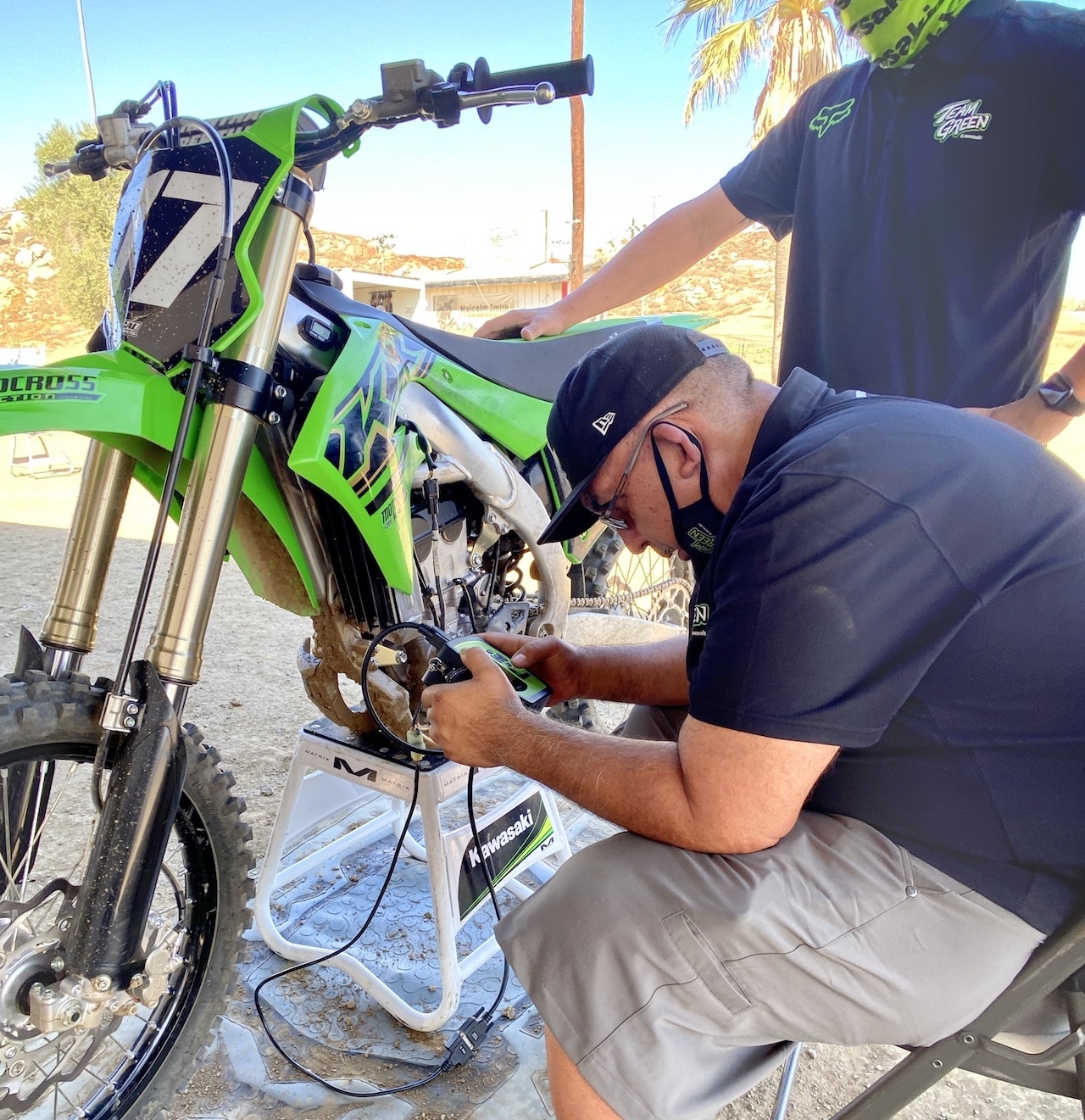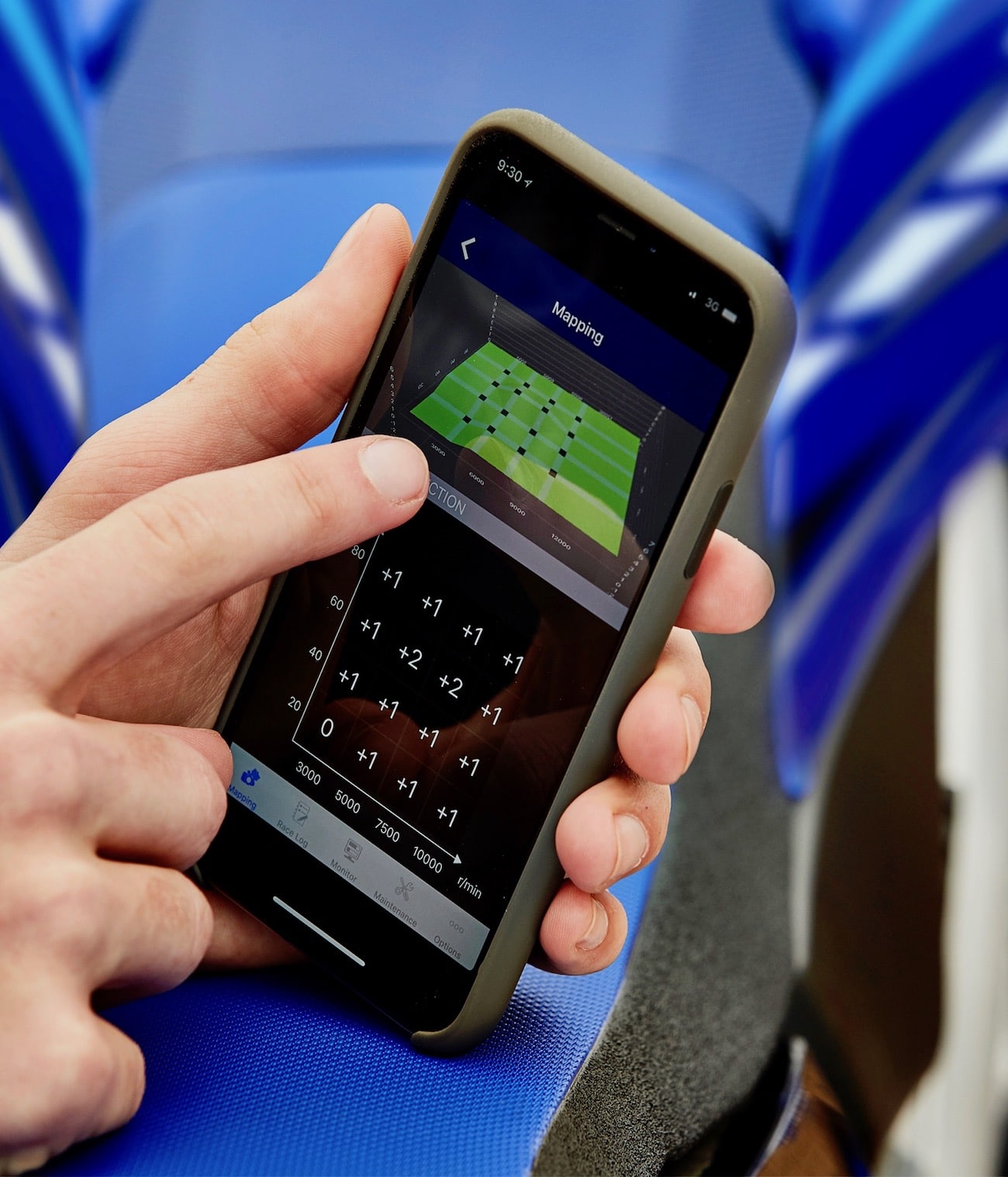TEN THINGS YOU NEED TO KNOW ABOUT ELECTRONIC CONTROL UNITS (ECU)
 Kawasaki’s Mike Chavez mapping MXA’s 2021 Kawasaki KX250.
Kawasaki’s Mike Chavez mapping MXA’s 2021 Kawasaki KX250.
(1) What does an ECU do? The ECU’s main function is to send a signal to the spark plug to spark when appropriate. It also works in connection with the stator. You will notice that the four-stroke EFI stator has many pick-ups. Those pick-ups are there to constantly update the ECU on where the crankshaft is so it knows when to spray the fuel and schedule ahead for things that are going to happen in the future. The ECU also works in conjunction with all of its extremities, such as the MAP sensor, TPS sensor, IAT sensor, ECT sensor and much more. The ECU can do all this faster than we can process our thoughts. On a carbureted bike, all that’s important is when it is going to spark.
(2) Global setting. When an OEM ships a bike to its dealers worldwide, typically it is with a global setting, meaning that the suspension, ECU settings and engine have to function in different climates, elevations, terrains, and temperatures. They have to meet different emissions standards, and work with different qualities of gas. This creates a lot of challenges. To meet these challenges, KTM uses a room where the engineers can run or start a bike and change the temperature in the room to mimic every climate. Manufacturers typically detune their bikes to the lowest common denominator, because not all countries have readily available high octane and high-quality fuel.
(3) Caring for the electrical system. How well you take care of your bike determines how well it will run. The ECU is one of the most important systems on the bike and the most overlooked. Make sure to blow away the water that sits where the connectors hang down—and the terminals—with an air gun to ensure that water doesn’t interrupt your electrical system. After a mud race, it’s not uncommon for a factory mechanic to take the wiring harness off the bike, wash it out throughly, and let it hang out to dry for the night. Water in the electrical system is the most common cause of problems.
 Yamaha has a smartphone app that connects to your YZ250F or YZ450F via WiFi to adjust the power.
Yamaha has a smartphone app that connects to your YZ250F or YZ450F via WiFi to adjust the power.
(4) Voltage sensor. A current sensor is a device that detects electrical current in a wire and generates a signal proportional to that current. The generated signal can then be used to display the measured current in an ammeter, or can be stored for further analysis in a data-acquisition system.

(5) TPS sensor. A throttle position sensor (TPS) is a sensor used to monitor the butterfly’s position. The sensor is usually located on the butterfly spindle/shaft so that it can directly monitor the position of the throttle.
(6) Lamda sensor. Companies like Twisted Development fine-tune ECUs with a Lamda sensor (also called a Wideband sensor). This sensor is fixed into the head pipe while the bike is on the dyno to track the amount of air and fuel per exhaust. The reason they put it directly into the pipe is because there is always a delay when you run a sniffer system. The Lamda sensor is used on all factory bikes to report information to the on-board data system.
(7) Engine coolant temperature sensor. This sensor has two functions. First, it richens the circuit for starting. For example, if it is cold outside, the ECU gets a signal from the coolant temperature sensor telling it to richen up the mixture; however, it only adds the fuel for a certain amount of time, which is called “decay time.” This makes the bike easy to start. If your bike is hard to start, this sensor might be the culprit, because it is not adding fuel when it is really cold. Second, if the bike gets really hot, there is a trim table programed in that will add fuel to prevent it from getting even hotter. As the sensor gets warmer, you can program the ECU to essentially shut down the engine so it doesn’t melt down, or you can richen it up a certain amount so you can finish the moto.
(8) MAP. The Manifold Absolute Pressure, or MAP, does double duty as the barometric pressure sensor. When the bike is started, this sensor takes a screenshot of what the absolute pressure is. If you are at sea level, the bike will either richen or lean itself out based on the trim table it is set at. This is also the sensor that records elevation.
(9) Air temperature sensor. This sensor richens or leans based on whether it is hot or cold outside.
(10) ECU performance. Companies like Twisted Development are able to tune most brand’s ECUs (save for KTM, Husky & GasGas); however, stock ECUs are “beta-based,” which means whenever you look at the preprogrammed map, all you see is a zero. You have no idea what the raw value from the factory engineers actually is, so you’re going in blind. The manufacturers leave enough adjustment parameters to make significant differences to the ECU possible. Twisted Development tells us that most problems can be resolved with available OEM software. But, to really have a custom bike that runs exactly the way you want it to, aftermarket-tuned ECUs, such as those from GET and Vortex, are the way to go.






Comments are closed.